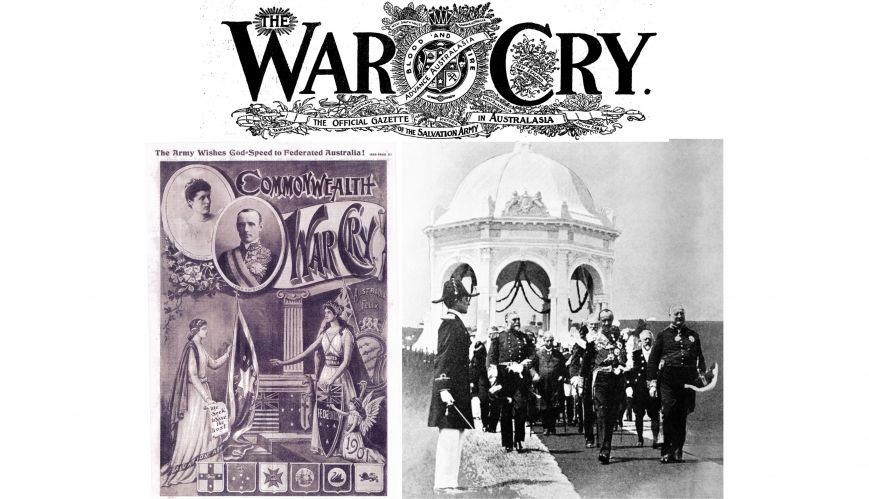Celebrating 120 years since Federation in Australia

Celebrating 120 years since Federation in Australia
In the push for Federation, The Salvation Army’s War Cry adopted a new masthead incorporating an Australian coat of arms and an ‘Advance Australasia’ banner. Also pictured is a slide from the Limelight Department’s federation film of Lord Hopetoun departing the Rotunda after signing the Federation document (right) and a special edition Federation War Cry.
Australia will celebrate 120 years as a federated nation on 1 January 2021. The Salvation Army contributed in a unique way to the weaving of Federation and continues to contribute and is firmly woven into the very fabric of Australian society today.
 Commandant Herbert Booth.
Commandant Herbert Booth.
Commandant Herbert Booth, the youngest son of William and Catherine Booth, arrived in Melbourne on 25 August 1896 to assume command of The Salvation Army in Australasia.
Booth was intelligent, entrepreneurial and godly, and, above all, a man of action. Three months after landing in the Antipodes, he launched his ‘Move-on Manifesto’, an ambitious social plan based on General Booth’s scheme of social salvation outlined in his book, In Darkest England and the Way Out.
Herbert was quick to tap into the pulse of the various self-governing Australian colonies as the populace was being encouraged to unite into an Australian Commonwealth, but not all colonials were in favour of a Federation movement.
Herbert Booth quickly threw his Salvation Army cap into the ring in support of various Federation leagues and societies advocating for Federation. Booth stated that his public political stand was done “in a desire to remove those boundaries which separate peoples and nations”.
The War Cry’s new masthead adopted the Army’s crest incorporating an Australian coat of arms and an ‘Advance Australasia’ banner. Two touring groups, the ‘Federal Band’ and the ‘Federal Choristers’ were raised by Herbert, and they toured Australia proclaiming the Gospel and promoting Federation.
In 1900, after years of drafting and debating, Australia’s Constitution was passed by the British Parliament and given royal assent by Queen Victoria in July; Australia’s six British colonies were destined to become one nation on 1 January 1901.
It had been determined that the ceremony proclaiming the Inauguration of the Commonwealth would occur in Sydney.
The Colonial Government of NSW determined that the event would be recorded for perpetuity by the cinematographe, and Australia’s largest motion picture producer at that time, The Salvation Army’s Limelight Department, was retained for the task.
The Limelight Department had been formed as a Brigade in 1891. Herbert was impressed with its prowess and in 1897 had successfully expanded it from Magic-Lantern production and exhibition capabilities to include motion-picture films.
On 1 January 1901, from elevated camera platforms erected along the route of the grand parade, three camera crews filmed more than 10,000 people. These included military bands, troops, mounted police, stockmen, tradesmen and fire-fighters, together with government representatives and community and religious leaders proceeding from Sydney’s Domain through the city streets to Centennial Park where Australia’s first Governor-General, the Earl of Hopetoun, presided as the Commonwealth of Australia was proclaimed.
 Captain Robert Sandall.
Captain Robert Sandall.
As a point of interest, the actual signing of the ‘inauguration’ document by Lord Hopetoun and the moment we became a nation was filmed by Captain Robert Sandall who later wrote the first three volumes of the official History of The Salvation Army.
Victoria, for its part, would host the first Commonwealth Parliament in the spectacular Melbourne Exhibition Building. Victoria’s Colonial Government also retained the Limelight Department to record the auspicious occasion of the Duke of Cornwall and York (later King George V) opening the first Federal Parliament on 9 May 1901.
Alas, the sitting of our first Parliament could not be recorded on motion-picture film, for the interior of the Exhibition Building proved to be far too gloomy. Fortunately, Tom Roberts was on hand to spectacularly render the event with paint on canvas.
Limelight Department camera crews had to be content with filming the royal procession as it made its way through the streets of Melbourne to the Exhibition Building. However, the breaking of the flag atop the building’s huge dome, signifying Parliament had sat, was significantly recorded for posterity.
The final film was entitled ‘Inauguration of the Commonwealth’ and represents the first time the birth of a nation was recorded on motion picture film. It was the Limelight Department’s first all film production, running for 35 minutes, and more than five times longer than any previous Australian film. It was Australia’s first feature-length documentary and the first use of multi-camera coverage; it was the most widely distributed Australian film of its time.